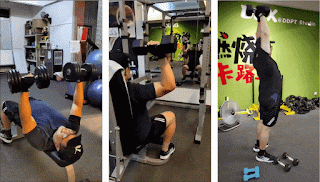Strength Training: King Solomon's court of Orchestrating Your Muscles Workouts
Hey buddy,
So, you know how our chest, triceps, hamstrings, and shoulders sometimes feel like they're on a coffee break while our quads, back, biceps, and calves are in the gym, hitting weights like it's a Friday night party? It's like they got a memo saying, "Sorry, we're closed for heavy lifting today."
Well, here's the deal. Our muscles are a diverse bunch, like a team with different players. To paraphrase Menno Henselmans of T Nation, some are sprinters (fast twitch), others are marathon runners (slow twitch). That's the muscle fiber composition playing its part. The fast ones like short, intense workouts, while the slow ones prefer the long and steady grind.
And then there's the biomechanics. Picture it like the blueprint of a building. The physical structure of a muscle determines how it responds to our training antics. It's like knowing the right dance moves for each song. Quads and back might be into the heavy rock, while triceps and hamstrings are more into a smooth jazz groove.
Now, our approach to training matters. Heavy weights can feel like a rock concert to our nervous system, joints, and connective tissues, as explained by Steve Shaw, an experienced raw masters powerlifter with decades of iron game experience. It's like asking your grandma to headbang; sometimes, it's just too much.
So, how do we turn these wallflowers into dance floor divas? First up, specialization training. It's like giving our neglected muscles the VIP treatment. Imagine them with a "Reserved" sign on the bench press. Here’s a sample 4-day specialization training routine focusing on chest, triceps, legs (including hamstring) and shoulders:
Remember, the key to specialization training is to focus on the muscle groups you want to improve, but without neglecting the rest of your body. Always listen to your body and adjust the routine as needed. If you’re unsure about any aspect of your training regimen, it may be beneficial to consult with a fitness professional. They can provide personalized advice based on your individual needs and goals. Happy training! 💪
Here are some tips from T-Nation & Gymaholic to consider when designing your own specialization program:
- Prioritize the muscle group you want to target by training it more frequently and with more sets and reps.
- Use isolation exercises that target the specific muscle group.
- Incorporate variation into your training to keep your muscles challenged 2.
- Use progressive overload to gradually increase the intensity of your workouts 2
Then, think of compound exercises as the main course. Paraphrasing Pete Cerqua, a certified Personal Trainer and a five-time best-selling author on fitness and nutrition: Deadlifts and squats are like the headliners of our workout playlist. Start strong, hit the big motions early when our muscles are still doing vocal warm-ups. Here’s a list of compound exercises that target multiple muscle groups:
After that, it's time for the supporting acts. Targeted exercises are like the solo performers. Curls for the biceps, lateral raises for the shoulders – it's their time in the spotlight.
But, hey, consistency is the real backstage pass. The more consistent we are, the more our muscles get used to the rhythm. Slowly crank up the volume, challenge them, and watch the encore performance improve.
Now, Imagine King Solomon's court, a symphony of order, wisdom, and splendor.
It's like our muscle training journey, where every move has a purpose. In the court, roles were defined, much like our muscles with their unique fiber composition. Some sprint, some go the distance.
Specialization training is our way of assigning tasks, ensuring each muscle plays its role like courtiers in a royal drama. King Solomon's wisdom? That's the biomechanics guiding our choices. Squats for quads, deadlifts for back – it's like having the right advisor for every situation.
The grand entrance of Queen Sheba? That's our compound exercises – deadlifts, squats – setting the tone. Engaging multiple muscles, it's the grand reveal of our strength. Now, the courtiers in their finest attire? Think targeted exercises. Triceps, chest, shoulders – each showcasing their skills, just like the court members flaunting their talents.
Order and synchronization in the court? That's the consistency in our workouts. Like the court maintained its splendor daily, our routines refine movements, allowing muscles to adapt and perform at their best.
So, our workout journey, like King Solomon's court, has defined roles, wisdom in biomechanics, grand entrances, individual showcases, and the consistency that maintains the order. And for the regal touch, think of Queen Sheba's awe in 1 Kings 10:4-5 (NIV):
"When the queen of Sheba saw all the wisdom of Solomon and the palace he had built, the food on his table, the seating of his officials, the attending servants in their robes, his cupbearers, and the burnt offerings he made at the temple of the Lord, she was overwhelmed."
Hope this helps. If it does, please UPVOTE, COMMENT, & SHARE.
May you be blessed with the power of David and the wisdom of Solomon.
Faithfully yours,

Comments
Post a Comment